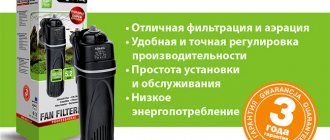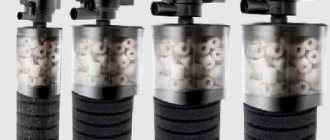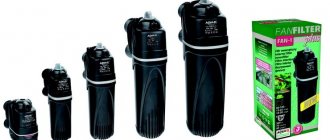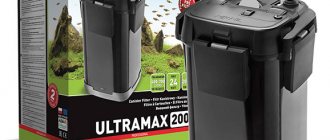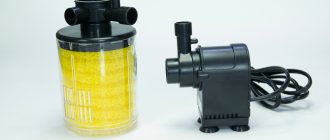Internal filters AQUAEL FAN-FILTER-1,2,3
OPERATION MANUAL FOR INTERNAL FILTERS AQUAEL FAN-filter -1, 2, 3
PURPOSE Internal filters from the FAN plus series are designed for cleaning and aerating water in aquariums. Aeration of water is carried out using: • intensive movement of water at the surface; • aeration nozzle (16); • additionally purchased diffuser. The filters are designed in such a way that they guarantee efficient operation and ease of maintenance even for the novice aquarist. CONDITIONS OF SAFE OPERATION Aquarium filters from the FAN plus series are manufactured in accordance with all currently valid safety regulations. Before each operation related to filter maintenance, for example, installation, replacement of fillers, cleaning, and always before putting your hand into water, the filter and other electrical equipment are disconnected from the electrical network. Do not use a filter that has any mechanical damage, such as a crack, or with damaged electrical wires. Do not change or repair electrical wires. Switches and plug connectors must not be mounted on the electrical wire. If the electrical wire is damaged, the entire pump must be replaced. The filter can only be used in room conditions, for liquids with temperatures up to 35 degrees Celsius. It can only be installed in aquariums and cannot be used for other purposes! The filter must be completely immersed in water and should not be allowed to run dry. INSTALLATION AND ADJUSTMENT The method of installing the filter in the aquarium is shown on the title page. The stand (13) together with the suction cups (12) or the optional magnetic suspension (17) allow you to easily and quickly install the filter at any selected height. The tube (9) must be connected on one side to the aeration nozzle (16), and on the other side to the aeration regulator (10). This will ensure effective aeration of the water in the aquarium. Thanks to the possibility of aeration, the filter has a useful diffuser function for enriching water with carbon dioxide. Additionally, using the regulator knob (10), you can adjust the intensity of aeration. The highest filter efficiency can be achieved by immersing the filter at a height of at least 3 cm below the water level. It must be remembered that as a result of evaporation, the water level in the aquarium is constantly decreasing. This fact should be taken into account when choosing the filter mounting height. In addition, with the help of flow regulators (4), it is possible to regulate the pump's performance over a wide range, and thanks to the installation of a rotating outlet dome (7), the water stream can be directed in any direction. Additionally, the FAN plus filter is equipped with a guide tip (8). FAN plus filters can be equipped with a diffuser (15) as an additional element. Diffuser installation method: according to the picture on the title page. REPLACEMENT OF FILTRATION MATERIAL, MAINTENANCE To clean the filter, first of all, you need to remove the plug from the electrical outlet. After this, lightly remove the entire filter from the stand (13) and remove it from the aquarium. In order to replace the filter inserts, it is necessary to remove the reservoir (1) from the filter by lightly pressing it with your fingers in the places indicated in the figure adjacent. After this, rinse and replace the liner. The filtration insert is made of a phenol-free sponge, on which bacterial cultures responsible for removing organic contaminants are especially easy to multiply. For filters FAN-2 plus and FAN-3 plus, it is possible to additionally purchase a biological kit (14), consisting of a ceramic liner and activated carbon. This set can replace a regular liner made of sponge (2). Activated carbon must be rinsed in running water before adding it to the tank. Filters from the FAN plus series are driven by a sealed, synchronous motor that does not require complex maintenance. However, at least once a month it is necessary to remove the reservoir (1) and the rotor chamber cover (18), remove the rotor (b) and carefully clean it. Then you need to fold the filter in the reverse order. After installing the rotor (6) on the axis, the rotor should rotate without any stop. DISMANTLING AND DISPOSAL Used electrical and electronic household equipment must not be disposed of in waste bins. The selection, collection and proper disposal of this type of waste contributes to the protection of valuable environmental resources. This allows you to avoid the negative consequences associated with environmental pollution with waste of this kind. Improper handling of used equipment, in turn, can pose a health hazard to people and animals. The user is the person responsible for delivering used equipment to a specialized collection point, where this equipment will be accepted free of charge. Information about such items can be obtained from the manufacturer's point of sale or service point.
Review of internal filters for aquarium AQUAEL
Polish company AQUAEL
has been known to Russian aquarists for a very long time. Even at the “old Bird Market” in Moscow you could find cute green boxes - internal filters for an aquarium of the “FAT” series. For me, such a filter also became the first aquarium equipment in my life more than 20 years ago. These filters were distinguished by their affordable price and excellent quality - some aquarists still use them to this day.
Since then, AQUAEL has grown very much and produces a huge range of aquarium equipment (you can read more about the history of AQUAEL here).
Internal aquarium filters are still an important part of the AQUAEL equipment line. It is represented by the following series:
FAN
UNIFILTER+ UV TURBO ASAP
and the
PAT
, consisting of a single PAT-mini filter.
Why so many? Let's try to figure it out.
FAN
Entry level filters. The simplest ones, without any special frills or “tricks” - just a pump, a sponge and a “glass”. This line has been produced without significant changes for many years and allows it to meet the needs of beginning aquarists. Well suited for aquariums with a small number of fish.
In addition to filtration itself, it is possible to enable additional aeration of water with air using a Venturi tube, the nozzle for which is included in the kit.
However, when choosing a filter of this series, you should remember that it will not be possible to put some kind of filler inside (activated carbon, zeolite, absorber of phosphates, nitrates, etc.), the filter design does not provide additional compartments. Therefore, the capabilities of these filters are limited exclusively to mechanical filtration and (if necessary) additional aeration.
The line includes 5 models:
| FAN-micro | FAN-mini | FAN-1 | FAN-2 | FAN-3 | |
| Aquarium volume, l* | up to 30 | 30-60 | 60-100 | 100-150 | 150-250 |
| Productivity, l/h | 250 | 260 | 320 | 450 | 700 |
| Dimensions (cm) | 4.7x6.7x9.7 | 4.4x5.3x15.1 | 5.5x5.6x19.7 | 6.6x7.7x25.5 | 8.2x9.4x27.6 |
*Here and below are data provided by the manufacturer.
(we omitted the prefix “PLUS”, which was introduced to distinguish filters of the “new” generation from the old ones, because this was a very long time ago and you definitely won’t find filters without “PLUS” on sale)
When choosing a filter, it is always wiser to adhere to the first number in the manufacturer’s recommendation - for example, if you have a 100-liter aquarium, it is better to choose the FAN-2 model rather than the FAN-1, although the latter is formally also suitable. This way you will ensure higher quality water filtration and the ability to clean the filter a little less often. Although in the case of an internal filter, this should in any case be done at least once a week.
This rule is useful when choosing filters of any type (both internal and external) from any manufacturer.
The FAN filter consists of 3 parts - a pump (filter head) with a rotor that powers the filter, a filter sponge and a glass that hides from view the not always pleasant-looking fish waste that gets into the filter.
Of course, the “MIKRO” model has the smallest sponge (indeed, “microscopic”), and the “3” has the largest. The larger the aquarium, the more fish usually live in it and, accordingly, more waste is produced.
Ideally, the sponge should be rinsed in water drained from the aquarium, squeezing it vigorously with your hand several times so that most of the contaminants remain in the water. If you rinse a sponge under the tap, on the one hand, it can be washed more thoroughly, but on the other hand, colonies of beneficial bacteria will be washed away.
Over time, the sponge will wear out, lose its shape and may even tear. It also begins to fit poorly and allows water to pass by, so it needs to be changed from time to time, approximately once a year. Sponges for internal AQUAEL filters are always on sale.
Consumables and accessories (click on the article to go to the product card)
| FAN-micro | FAN-mini | FAN-1 | FAN-2 | FAN-3 | |
| Sponge | 101186 | 101309 | 100147 | 100792 | 100793 |
| Suckers | 100491 | 100491 | 100491 | 100492 | 100492 |
| Rain nozzle | 100500 | 100500 | 100500 | 100500 | 101145 |
UNIFILTER-UV
Unique internal filters with a built-in UV sterilizer using special UV LEDs. Initially, it also included “regular” filters, without LEDs, but since they were no different in functionality from the main FAN series, the manufacturer decided to remove them from the range.
A UV sterilizer allows you to achieve greater purity of water, as UV radiation destroys microorganisms floating by, which largely make up the turbidity. It also destroys dyes (the “yellow water” effect) and reduces the concentration of pathogens, reducing the microbial load on fish.
The line consists of three models:
| UNIFILTER 500-UV | UNIFILTER 750-UV | UNIFILTER 1000-UV | |
| Aquarium volume, l | 100-200 | 200-300 | 250-350 |
| Productivity, l/h | 500 | 750 | 1000 |
| Dimensions (cm) | 5.8x9.9x22.2 | 6.7x11.2x25.5 | 6.7x11.2x30.8 |
All models have the same 0.5 W UV sterilizer. It is powered by a separate cord, so you can turn the UV sterilization on and off independently of the filter itself (of course, it should only be turned on when the filter is running).
Also, the UNIFILTER model is distinguished from the rest by the presence of not one, but two sponges in the filter housing - this made it possible to increase the area of contact with water, which improves filtration.
The older model (1000 UVPOWER) is equipped with a container with a filler for biological filtration (AQUAEL Bioceramax 600), which, if necessary, can be replaced with any other.
Of course, original sponges for these filters are also easy to buy.
| UNIFILTER 500-UV | UNIFILTER 750-UV | UNIFILTER 1000-UV | |
| Sponge | 100757 | 100760 | 100760 |
| Suckers | 100492 | 100492 | 100492 |
| Rain nozzle | 101145 | 101145 | 101145 |
TURBO
“Heavy artillery” among AQUAEL internal filters. When for some reason it is not possible to install an external filter, but there are quite a lot of fish in the aquarium and quite serious filtration is required, filters from the TURBO- FILTER
.
Their design is simple - there is a pump on top (they can be purchased separately - the CIRCULATOR series), under it there is a container with biological filler (included is AQUAEL Bioceramax PRO 600, but can be replaced with any other at your discretion), and at the very bottom - a rather voluminous a ribbed sponge, this time not covered by a glass.
The line includes 4 models.
| TURBO-500 | TURBO-1000 | TURBO-1500 | TURBO-2000 | |
| Aquarium volume, l | up to 150 | 150-250 | 250-350 | from 350 |
| Productivity, l/h | 500 | 1000 | 1500 | 2000 |
| Dimensions (cm) | 7×7,6×23,9 | 10,1×11,3×30,3 | 10,1×12,2×32,4 | 10,1×12,2×32,4 |
The filter of the “500” model is small, and the filters of the “1000”, “1500” and “2000” models have more impressive dimensions and differ from each other only in the pump - the size of the sponge and the volume of the container with the filler are absolutely the same.
Please note that for any model you can purchase an additional container (or even several, but you shouldn’t get carried away - the pump power may not be enough to pump water) for bulk fillers and put activated carbon, zeolite or any other filler there.
These filters also allow you to connect additional aeration using the Venturi system, but remember that this reduces the filtration efficiency as the volume of pumped water decreases.
It should be remembered that filters of the “TURBO” series have a slightly higher operating noise than filters of other series.
| TURBO-500 | TURBO-1000 | TURBO-1500 | TURBO-2000 | |
| Sponge | 109736 | 109737 | 109737 | 109737 |
| Container | 109733 | 109735 | 109735 | 109735 |
| Suckers | 100491 | 110161 | 110161 | 110161 |
| Rain nozzle | 100500 | 101145 | 101145 | 101145 |
ASAP
In English, the abbreviation “ASAP” stands for “As soon as possible.” In this case, this applies to the filter maintenance process, but first things first.
In a sense, these are unique filters, everything in them is turned upside down: the pump pumping water is located not at the top, like all other filters, but at the bottom, water from the aquarium enters it, and is then pushed up through a sponge and comes out at the very top of the filter.
What was achieved with this design?
- There is no need to remove the entire filter for cleaning; the glass with sponge is easily detached from the pump and just as easily installed back. It is recommended to wash the pump itself approximately once every 4-5 sponge cleanings, so you will still have to take it out from time to time.
- Water comes out from above in a wide stream, which improves aeration without the use of a rather noisy Venturi system (these are the only AQUAEL filters that do not have it and cannot be installed additionally).
- The filter can operate even at very low water levels (starting from 5 cm). This is especially critical for aquaterrariums. Water will flow out from above, forming a waterfall.
- The water flow can be directed in any direction by simply turning the filter “glass”.
A nice and modern appearance can also be attributed to the advantages of ASAP series filters.
The ASAP series is available in three versions
| ASAP 300 | ASAP 500 | ASAP 700 | |
| Aquarium volume, l | up to 100 | 50-150 | 150-250 |
| Productivity, l/h | 300 | 500 | 650 |
| Dimensions (cm) | 5×7,6×15,4 | 5,4×8,8×18,6 | 6,5×9,9×24,4 |
You can separately purchase both a cartridge complete with a regular sponge and a carbon one for chemical filtration. Regular sponges are also sold separately, without a cartridge, which allows you to save money.
| ASAP 300 | ASAP 500 | ASAP 700 | |
| Sponge cartridge | 113742 | 113745 | 113748 |
| Sponge (2 pcs.) | 113732 | 113735 | 113739 |
| Carbon sponge cartridge | 113743 | 113749 | |
| Suckers | 100491 | 100491 | 100492 |
Well, as usual, the last on the list, but not the last in importance, is a filter that stands apart
PAT
MINI
| Aquarium volume, l | up to 120 |
| Productivity, l/h | 400 |
| Dimensions (cm) | 3,8×5,3×14 |
It's hard to think of something simpler - a small pump and a small corrugated sponge put on it. However, this filter is very popular among nano aquarium enthusiasts. Although the manufacturer indicates that it is suitable for aquariums from 10 to 120 liters, we still recommend it if your aquarium capacity is no more than 30 liters. For large volumes, it is still better to choose a more powerful option.
In the photo above is a corner of the AQUAEL Shrimp set aquarium, the filter is not included in the kit.
The absence of a “glass” makes this filter an acceptable solution for shrimp farmers, since thanks to this there is no danger of young shrimp being sucked inside, because water is absorbed evenly through the entire surface of the sponge.
And of course, don’t forget that this is the most inexpensive internal filter from AQUAEL.
| PAT MINI | |
| Sponge | 108860 |
| Suckers | 100491 |
| Rain nozzle | 100500 |
(c) 2021 Nikultsev Alexander Yurievich
